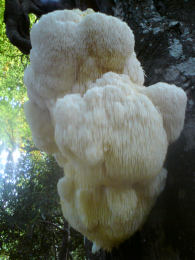
Photo by Diane Cavallero (rogersmushrooms.com)
By Brian Matson
The genus Hericium has several conspicuous species in the forests of North America, often hanging high up in the branches just out of reach or on the ground on dead logs. These saprophytic (wood-eating) mushrooms look unlike any other Basidiomycetes that you might see, lacking the cap and gill features so common to this phylum. What they are missing in commonality they make up for in beauty. Often weighing several pounds with an untarnished creamy white coloration make these fungi a treat worth looking for. Not only are they unique in appearance they are edible and choice, having a unique taste, they also show promising health benefits such as tumor reduction and stimulating the production of nerve growth factor (“Hericium: The Nerve Regenerators @ Mushrooms For Health,” n.d.).
There are four species of Hericium present in North America. Hericium erinaceus and Hericium abietis can be found in our Pacific Northwest and as far south as California on conifer wood. Hericium coralloides which is wide spread and grows on conifers , and Hericium americanum which can be found in the Great Plains growing on hardwoods. All four of these species have stalactite-appearing teeth that hang off off the fruiting body. They are an easy fungus to identify for beginner mycologists because there are no poisonous look-a-likes in North America. David Arora describes these fungi as having a similar flavor and texture to fish or lobster. It can be sautéed, marinated, grilled, or prepared in almost any fashion, making it a very flexible mushroom for cooking. My preferred method is to dry sauté the mushroom until the liquid has evaporated off, then adding 1-2 tbsp of avocado oil, frying until browned, and then sprinkling on a little salt. Patience is the key while cooking, because it often takes longer than you will want to wait. The wait is worth the euphoria trying this delicacy!
Hericium has been used as a traditional medicine in China and Japan for many years; but its medicinal uses are still being explored in western medicine (“Hericium: The Nerve Regenerators @ Mushrooms For Health,” n.d.) . The fungi in the genus Hericium all contain compounds called erinacines. Erinacines have shown the ability to stimulate the production of nerve growth factor in animal trials (“Hericium: The Nerve Regenerators @ Mushrooms For Health,” n.d.) , and show much potential in the treatment of debilitating diseases that affect nerve health or function. In a double-blind placebo controlled study that took place in Japan in 2008, participants whose ages ranged from 50-80 were given orally powdered Hericium erinaceus and their cognitive function was monitored. All 14 test subjects given the powdered Hericium erinaceus showed improved cognitive function when compared to 5 of the 15 placebo participants (Mori, Inatomi, Ouchi, Azumi, & Tuchida, 2009) . The studies show promise in the effectiveness of Hericium in treatment of neurological diseases. More studies are being done testing the effectiveness as a tumor suppressant, and while there has been less testing done in this area the few tests there have been show promise.
Works Cited
Plants & Fungi: Hericium erinaceus (bearded tooth) – Species profile from Kew. (n.d.). Retrieved February 9, 2014, from http://www.kew.org/plants-fungi/Hericium-erinaceus.htm
Hericium – Wikipedia, the free encyclopedia. (n.d.). Retrieved February 9, 2014, from http://en.wikipedia.org/wiki/Hericium
Hericium: The Nerve Regenerators @ Mushrooms For Health. (n.d.). Retrieved February 9, 2014, from http://mushrooms4health.com/hericium-the-nerve-regenerators/
The Genus Hericium (MushroomExpert.Com). (n.d.). Retrieved February 9, 2014, fromhttp://www.mushroomexpert.com/hericium.html
Mori, K., Inatomi, S., Ouchi, K., Azumi, Y., & Tuchida, T. (2009). Improving effects of the mushroom Yamabushitake ( Hericium erinaceus ) on mild cognitive impairment: a double-blind placebo-controlled clinical trial. Phytotherapy Research, 23(3), 367–372. doi:10.1002/ptr.2634
Yurchenco, J. A., & Warren, G. H. (1961). A Laboratory Procedure for the Cultivation and Fructification of Species of Hericium. Mycologia, 53(6), 566–574. doi:10.2307/3756458
